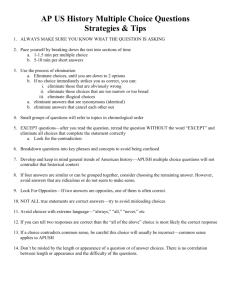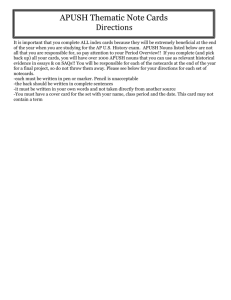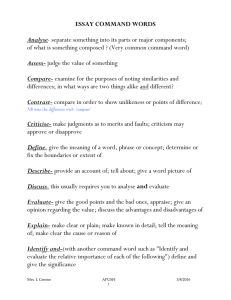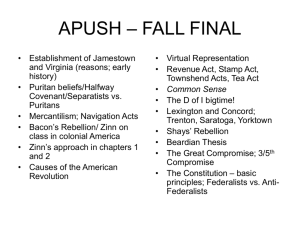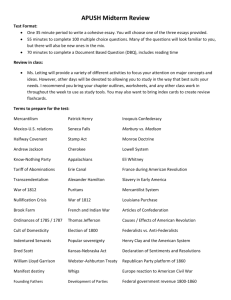APUSH 2015-16 Syllabus
advertisement
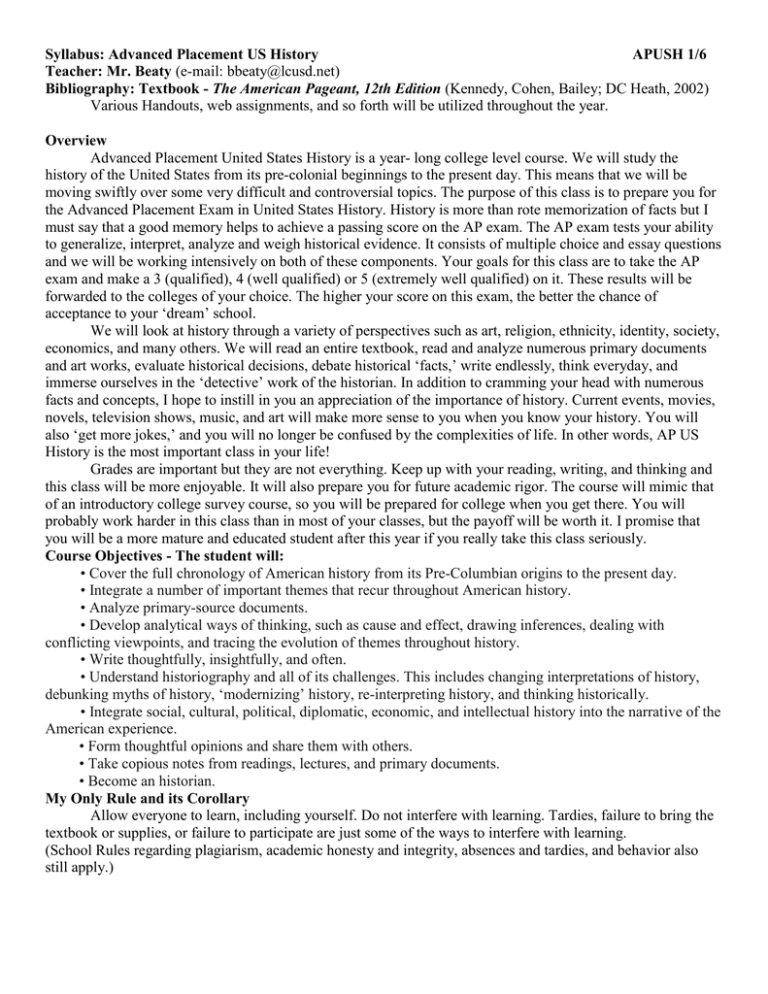
Syllabus: Advanced Placement US History APUSH 1/6 Teacher: Mr. Beaty (e-mail: bbeaty@lcusd.net) Bibliography: Textbook - The American Pageant, 12th Edition (Kennedy, Cohen, Bailey; DC Heath, 2002) Various Handouts, web assignments, and so forth will be utilized throughout the year. Overview Advanced Placement United States History is a year- long college level course. We will study the history of the United States from its pre-colonial beginnings to the present day. This means that we will be moving swiftly over some very difficult and controversial topics. The purpose of this class is to prepare you for the Advanced Placement Exam in United States History. History is more than rote memorization of facts but I must say that a good memory helps to achieve a passing score on the AP exam. The AP exam tests your ability to generalize, interpret, analyze and weigh historical evidence. It consists of multiple choice and essay questions and we will be working intensively on both of these components. Your goals for this class are to take the AP exam and make a 3 (qualified), 4 (well qualified) or 5 (extremely well qualified) on it. These results will be forwarded to the colleges of your choice. The higher your score on this exam, the better the chance of acceptance to your ‘dream’ school. We will look at history through a variety of perspectives such as art, religion, ethnicity, identity, society, economics, and many others. We will read an entire textbook, read and analyze numerous primary documents and art works, evaluate historical decisions, debate historical ‘facts,’ write endlessly, think everyday, and immerse ourselves in the ‘detective’ work of the historian. In addition to cramming your head with numerous facts and concepts, I hope to instill in you an appreciation of the importance of history. Current events, movies, novels, television shows, music, and art will make more sense to you when you know your history. You will also ‘get more jokes,’ and you will no longer be confused by the complexities of life. In other words, AP US History is the most important class in your life! Grades are important but they are not everything. Keep up with your reading, writing, and thinking and this class will be more enjoyable. It will also prepare you for future academic rigor. The course will mimic that of an introductory college survey course, so you will be prepared for college when you get there. You will probably work harder in this class than in most of your classes, but the payoff will be worth it. I promise that you will be a more mature and educated student after this year if you really take this class seriously. Course Objectives - The student will: • Cover the full chronology of American history from its Pre-Columbian origins to the present day. • Integrate a number of important themes that recur throughout American history. • Analyze primary-source documents. • Develop analytical ways of thinking, such as cause and effect, drawing inferences, dealing with conflicting viewpoints, and tracing the evolution of themes throughout history. • Write thoughtfully, insightfully, and often. • Understand historiography and all of its challenges. This includes changing interpretations of history, debunking myths of history, ‘modernizing’ history, re-interpreting history, and thinking historically. • Integrate social, cultural, political, diplomatic, economic, and intellectual history into the narrative of the American experience. • Form thoughtful opinions and share them with others. • Take copious notes from readings, lectures, and primary documents. • Become an historian. My Only Rule and its Corollary Allow everyone to learn, including yourself. Do not interfere with learning. Tardies, failure to bring the textbook or supplies, or failure to participate are just some of the ways to interfere with learning. (School Rules regarding plagiarism, academic honesty and integrity, absences and tardies, and behavior also still apply.) Supplies APUSH 2/6 1. Spiral bound notebook – the bigger the better. This will be your primary note-taking, idea forming, essayrough-drafting, ‘go-to’ everyday connection to this class. Get used to having a notebook with you throughout your academic career. 2. A loose-leaf notebook for handouts, exam tips, essay tips, etc. 3. A favorite pen, or two. Notes, essays, and research will be done primarily in pen. 4. A couple of pencils for multiple-choice tests. 5. A really good eraser. Those pink rubber erasers are no good. Get a good ‘plastic’ eraser. It will last forever, and it may save you a point or two on the AP exam. Class Expectations • Read, study, and take notes every night. Failure to do so will make our discussions more difficult to comprehend, and will jeopardize a passing AP Exam score. You are expected to take notes everyday while reading the text, essays, and documents, while listening to class lectures and discussions, and while studying. We will read from 2 – 3 chapters every week. Get ready for this withering load. • Don’t rely on online notes, Wikipedia, internet options, friends, rumors, or shortcuts. This may work in the short run, but you will not remember anything when the AP Exam rolls around. The internet is a great source of information, but I want you to use it as a single resource, not as your only resource. • Read the text, and any related material frequently, think about your reading everyday, write about history copiously (by hand with a pen), discuss history with everyone, think some more, read some more, and discuss some more. This is the best way to really ‘get’ history. • Connect what you read in history to what you read in the newspaper or what you see on television, or the movies, or online. Look for the ‘real’ story. Everything is connected! • Take the AP Exam in May. • Bring your book and notebooks to class everyday. Failure to do this may lower your grade and it will impede your understanding of history. Grades Your grade will be based on quizzes, tests, homework, projects, and research. You are also expected to participate in all class activities. Failure to succeed in any of these requirements could jeopardize your standing in the class. I reserve the right to dismiss from the class any who do not meet the requirements demanded by me and by the nature of the class. Exams 30% Long Essays and DBQs 25% SAQs 10% Homework/Projects/Research/Pop Quizzes/Participation-lowest score dropped 15% Final Exam 20% 100% 100-93 – A 92.9-90 – A89.9-86.5 – B+ 86.9-83 – B 82.9-80 – B79.9-77 – C+ 76.9-73 – C 72.9-70 – C69-60 – D 59 and below – F There will be no curving of your grade. If your grade is, say, 79.9, or 89.9, you will not be curved to the higher grade. Makeup Work/Late Work Attendance is crucial to doing well on the AP test. If you miss this class, for whatever reason, your grade and your understanding of history will be impaired. Tests, quizzes, essays, and other work must be made-up before school, during lunch, or after school on the earliest day as per the district make-up policy. Pop quizzes cannot be made up, but you will not be penalized. Your next pop quiz will count twice to make up for your excused absence. It is the student’s responsibility to make up all work (except pop quizzes). I will not “chase you down” to remind you of missed work. Assignments will only be accepted late for up to one week past due date, but the grade will be reduced by 50%. This means that work that is a day late will be counted down. All work not made up during this time will be scored as a “0.” Remember, luck has nothing to do with success on an AP exam. Your grade will reflect the amount of time that you commit to reading, thinking, discussing, and writing. Keep this syllabus with you at all times! Changes in the APUSH Curriculum APUSH 3/6 The new APUSH curriculum is significantly different from last year’s AP Euro curriculum. The redesign will challenge you and will appear to be less work than you’re used to doing. APUSH now requires you to think and connect more than past APUSH curriculums. What has not changed is the need to read extensively, think broadly, and write copiously. If you give less than your best effort your score will suffer. The details of the new exam are as follows: The most important components of the class will be connecting and extending the following skills to the themes of American History: APUSH Historical Skills Historical Causation Patterns of Continuity and Change over Time Periodization Comparison and Contrast Contextualization Historical Argumentation Appropriate Use of Relevant Historical Evidence Interpretation Synthesis APUSH Themes Identity Work, Exchange, and Technology Peopling Politics and Power America in the World Environment and Geography — Physical and Human Ideas, Beliefs, and Culture AP US History Pacing Plan APUSH 4/6 These dates are subject to change depending on the ‘flow’ of the class, natural disasters, and my discretion. APUSH Pacing Plan 2015/2016 Period/Unit 1 Date Range 1491-1607 Percentage/Days 5% – 6 or 7 days Week Number 1-2 Bailey Chapters 1,2 2 1607-1754 10% – 14 or 15 days 3-5 2,3,4,5,6 3 1754-1800 12% – 17 or 18 days 6-9 5, 6, 7, 8, 9, 10 4 1800-1848 10% – 14 or 15 days 9-12 5 1844-1877 13% – 19 or 20 days 12-16 6 1865-1898 13% – 19 or 20 days 7 1890-1945 17% – 25 days 17-1st semester final 2nd semester weeks13 4-7 11, 12, 13, 14, 15, 16, 17, 18, 19, 20, 21, 22 22, 23, 24, 25, 26, 8 1945-1980 15% – 22 days 8 – 10 to Spring Break 27, 28, 29, 30, 31, 32, 33, 34, 35, 36 37, 38, 39, 40 9 1980-Present 5% – 7 or 8 days 12-14 41, 42 Review 1491-Present 100% 14 or 15 days 15-17 APUSH Units and Key Concepts/Big Ideas PERIOD 1: 1491–1607 • On a North American continent controlled by American Indians, contact among the peoples of Europe, the Americas, and West Africa created a new world. 1. Key Concept 1.1 Before the arrival of Europeans, native populations in North America developed a wide variety of social, political, and economic structures based in part on interactions with the environment and each other. 2. Key Concept 1.2: European overseas expansion resulted in the Columbian Exchange, a series of interactions and adaptations among societies across the Atlantic. 3. Key Concept 1.3: Contacts among American Indians, Africans, and Europeans challenged the worldviews of each group. PERIOD 2: 1607–1754 • Europeans and American Indians maneuvered and fought for dominance, control, and security in North America, and distinctive colonial and native societies emerged. 1. Key Concept 2.1: Differences in imperial goals, cultures, and the North American environments that different empires confronted led Europeans to develop diverse patterns of colonization. 2. Key Concept 2.2: European colonization efforts in North America stimulated intercultural contact and intensified conflict between the various groups of colonizers and native peoples. 3. Key Concept 2.3: The increasing political, economic, and cultural exchanges within the “Atlantic World” had a profound impact on the development of colonial societies in North America. APUSH 5/6 PERIOD 3: 1754–1800 • British imperial attempts to reassert control over its colonies and the colonial reaction to these attempts produced a new American republic, along with struggles over the new nation’s social, political, and economic identity. 1. Key Concept 3.1: Britain’s victory over France in the imperial struggle for North America led to new conflicts among the British government, the North American colonists, and American Indians, culminating in the creation of a new nation, the United States. 2. Key Concept 3.2: In the late 18th century, new experiments with democratic ideas and republican forms of government, as well as other new religious, economic, and cultural ideas, challenged traditional imperial systems across the Atlantic World. 3. Key Concept 3.3: Migration within North America, cooperative interaction, and competition for resources raised questions about boundaries and policies, intensified conflicts among peoples and nations, and led to contests over the creation of a multiethnic, multiracial national identity. PERIOD 4: 1800–1848 • The new republic struggled to define and extend democratic ideals in the face of rapid economic, territorial, and demographic changes. 1. Key Concept 4.1: The United States developed the world’s first modern mass democracy and celebrated a new national culture, while Americans sought to define the nation’s democratic ideals and to reform its institutions to match them. 2. Key Concept 4.2: Developments in technology, agriculture, and commerce precipitated profound changes in U.S. settlement patterns, regional identities, gender and family relations, political power, and distribution of consumer goods. 3. Key Concept 4.3: U.S. interest in increasing foreign trade, expanding its national borders, and isolating itself from European conflicts shaped the nation’s foreign policy and spurred government and private initiatives. PERIOD 5: 1844–1877 • As the nation expanded and its population grew, regional tensions, especially over slavery, led to a civil war — the course and aftermath of which transformed American society. 1. Key Concept 5.1: The United States became more connected with the world as it pursued an expansionist foreign policy in the Western Hemisphere and emerged as the destination for many migrants from other countries. 2. Key Concept 5.2: Intensified by expansion and deepening regional divisions, debates over slavery and other economic, cultural, and political issues led the nation into civil war. 3. Key Concept 5.3: The Union victory in the Civil War and the contested Reconstruction of the South settled the issues of slavery and secession, but left unresolved many questions about the power of the federal government and citizenship rights. PERIOD 6: 1865–1898 • The transformation of the United States from an agricultural to an increasingly industrialized and urbanized society brought about significant economic, political, diplomatic, social, environmental, and cultural changes. 1. Key Concept 6.1: The rise of big business in the United States encouraged massive migrations and urbanization, sparked government and popular efforts to reshape the U.S. economy and environment, and renewed debates over U.S. national identity. 2. Key Concept 6.2: The emergence of an industrial culture in the United States led to both greater opportunities for, and restrictions on, immigrants, minorities, and women. 3. Key Concept 6.3: The “Gilded Age” witnessed new cultural and intellectual movements in tandem with political debates over economic and social policies. APUSH 6/6 PERIOD 7: 1890–1945 • An increasingly pluralistic United States faced profound domestic and global challenges, debated the proper degree of government activism, and sought to define its international role. 1. Key Concept 7.1: Governmental, political, and social organizations struggled to address the effects of large-scale industrialization, economic uncertainty, and related social changes such as urbanization and mass migration. 2. Key Concept 7.2: A revolution in communications and transportation technology helped to create a new mass culture and spread “modern” values and ideas, even as cultural conflicts between groups increased under the pressure of migration, world wars, and economic distress. 3. Key Concept 7.3: Global conflicts over resources, territories, and ideologies renewed debates over the nation’s values and its role in the world, while simultaneously propelling the United States into a dominant international military, political, cultural, and economic position. PERIOD 8: 1945–1980 • After World War II, the United States grappled with prosperity and unfamiliar international responsibilities, while struggling to live up to its ideals. 1. Key Concept 8.1: The United States responded to an uncertain and unstable postwar world by asserting and attempting to defend a position of global leadership, with far-reaching domestic and international consequences. 2. Key Concept 8.2: Liberalism, based on anticommunism abroad and a firm belief in the efficacy of governmental and especially federal power to achieve social goals at home, reached its apex in the mid1960s and generated a variety of political and cultural responses. 3. Key Concept 8.3: Postwar economic, demographic, and technological changes had a far-reaching impact on American society, politics, and the environment. PERIOD 9: 1980–Present • As the United States transitioned to a new century filled with challenges and possibilities, it experienced renewed ideological and cultural debates, sought to redefine its foreign policy, and adapted to economic globalization and revolutionary changes in science and technology. 1. Key Concept 9.1: A new conservatism grew to prominence in U.S. culture and politics, defending traditional social values and rejecting liberal views about the role of government. 2. Key Concept 9.2: The end of the Cold War and new challenges to U.S. leadership in the world forced the nation to redefine its foreign policy and global role. 3. Key Concept 9.3: Moving into the 21st century, the nation continued to experience challenges stemming from social, economic, and demographic changes. RETURN THIS PAGE TO MR. BEATY BY AUGUST 14th I have read through the syllabus for AP US History for the 2015-2016 School Year and I agree to abide by its rules and guidelines. Student’s Name (Printed): ___________________________________________ Student ID#__________________________________________ Student Signature: _____________________________________________________ Parent’s/Guardian’s Name (Printed): _______________________________________ Parent’s/Guardian’s Signature: ____________________________________________ Parent’s Guardian’s Email (please print clearly):________________________________________________
